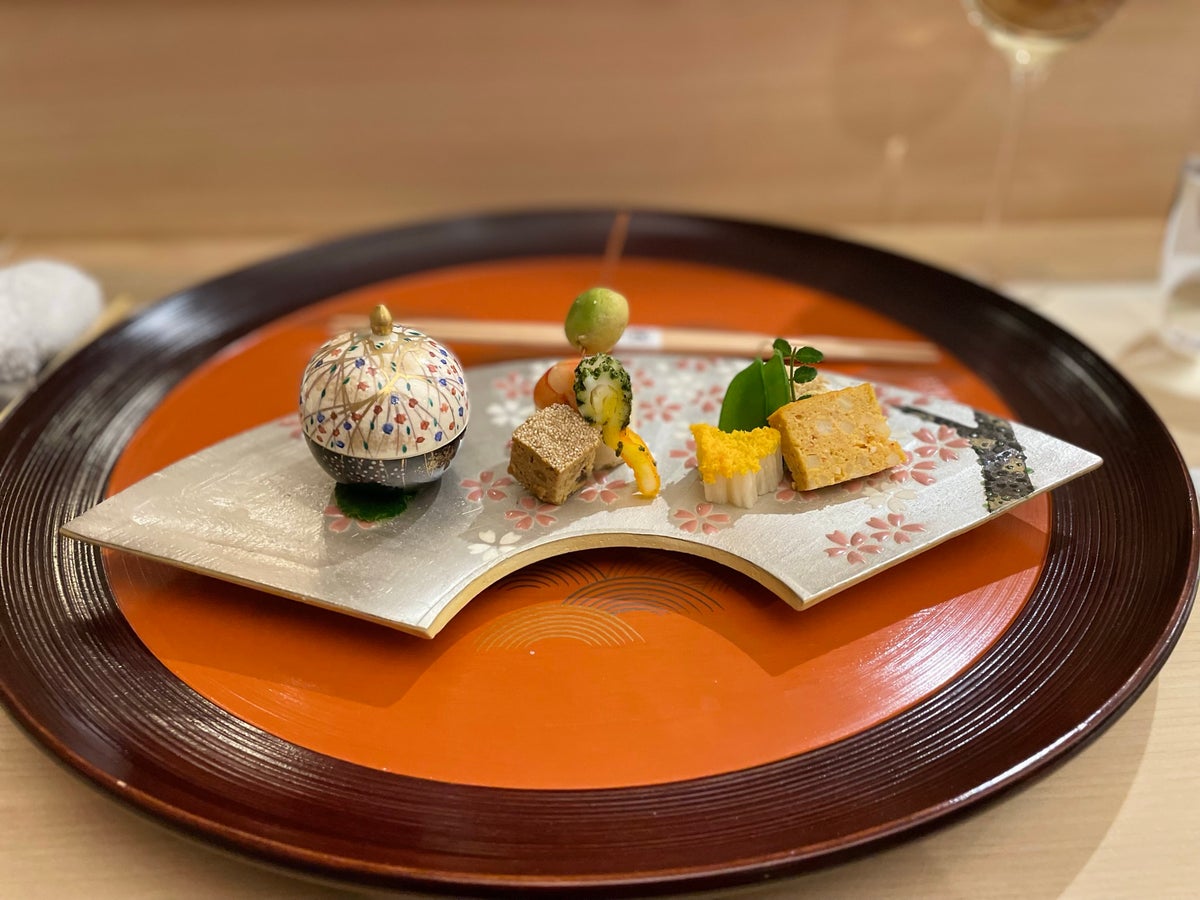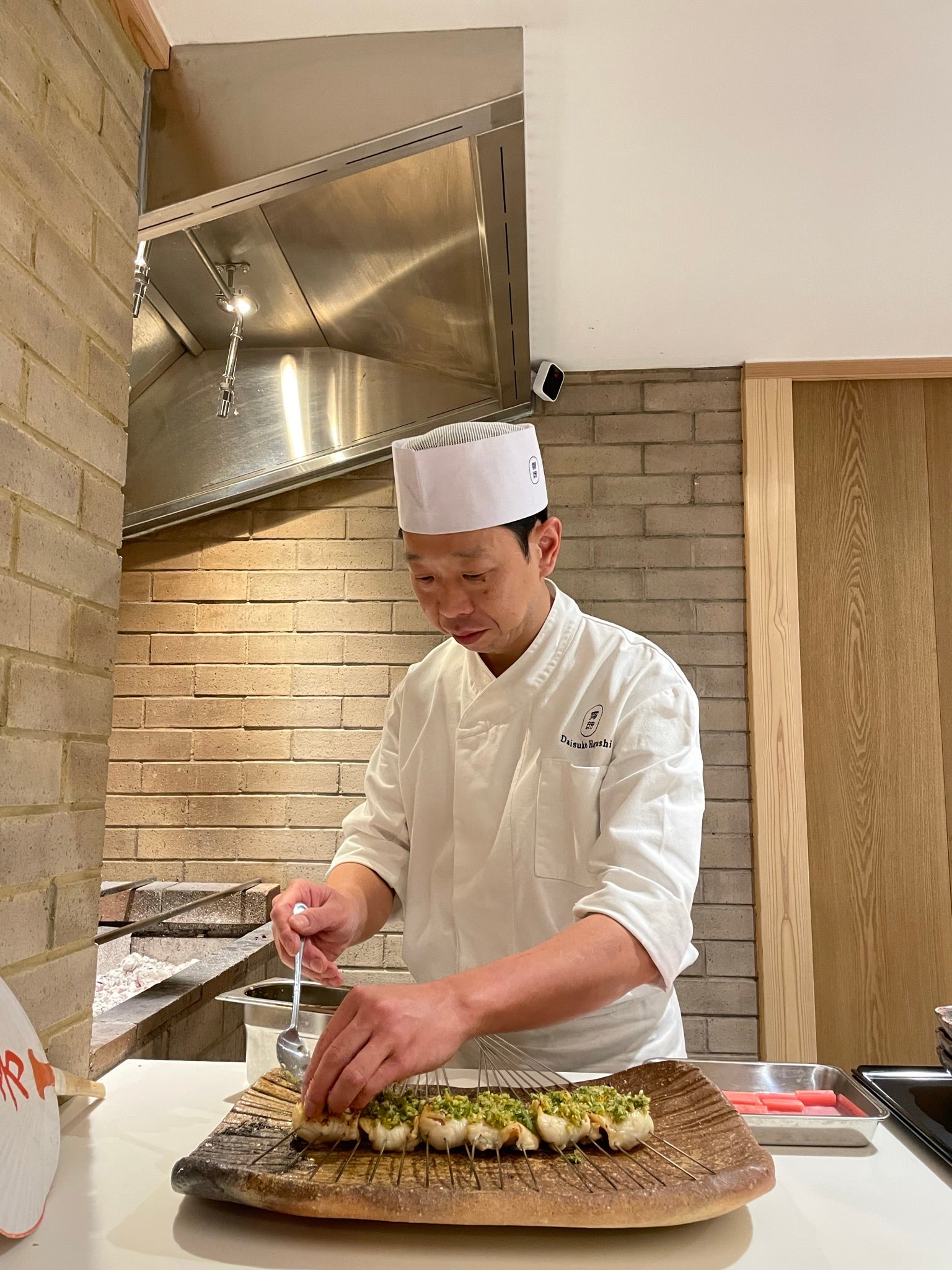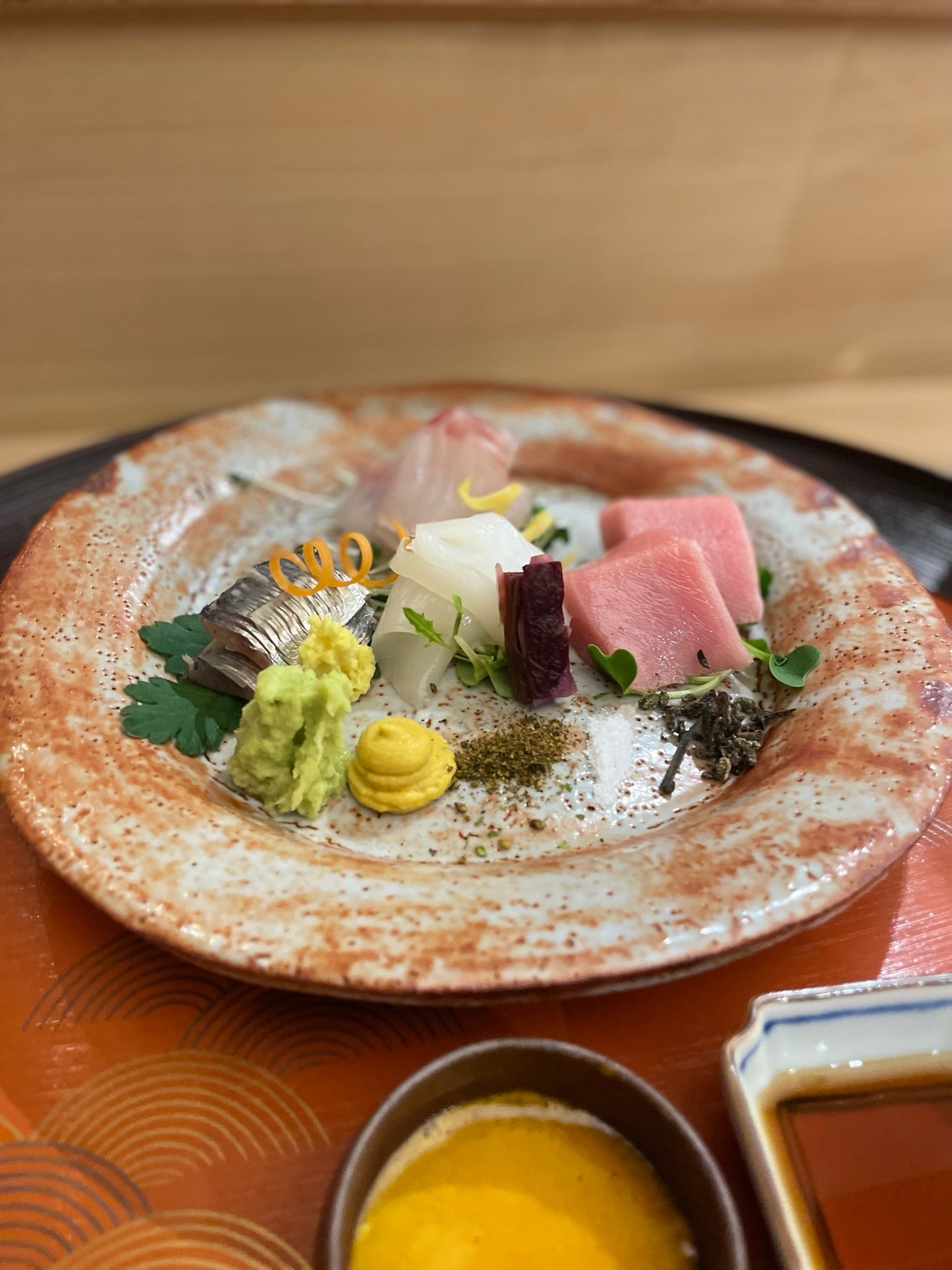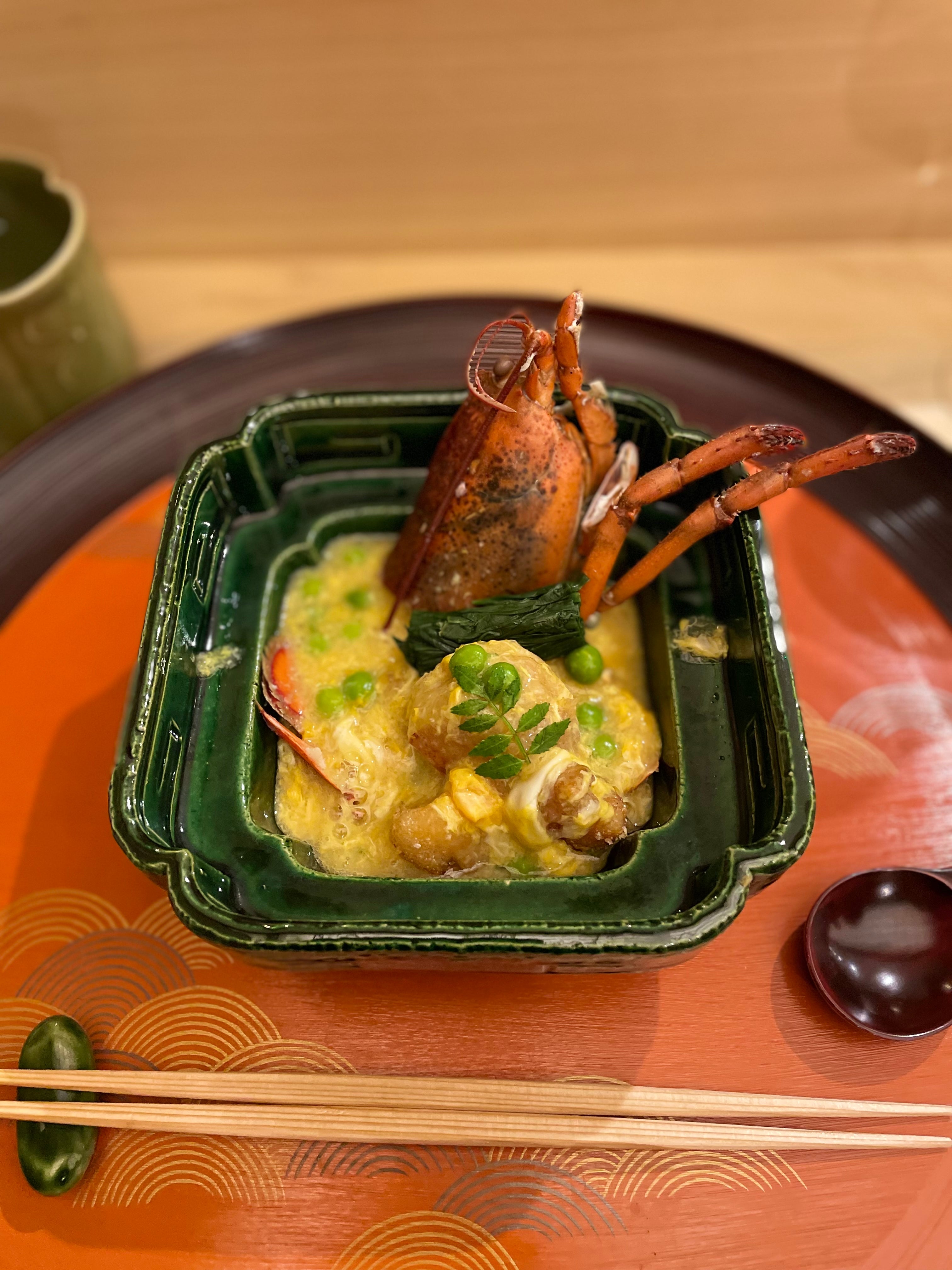
Way back at the start of this funny business called Covid, I had my dream trip to Japan planned. Three weeks of ryokan-hopping, onsen-dipping and kaiseki-dining. Alas, it was not meant to be, and I have spent a lot of time since trying to emulate the experience from afar.
So you can imagine my excitement at the opening of a new kaiseki restaurant in London: Roketsu. Kaiseki, considered to be the highest form of Japanese cuisine, refers both to a traditional multi-course meal consisting of a sequence of small dishes, and the skills required to prepare them. Originally served to Buddhist monks before tea ceremonies, the 10-course menu is usually centred around dashi (Japanese stock made from dried fish), guided by the flavours of the seasons and dictated by the philosophy of “wabi-sabi”, which is all about capturing the elusive beauty of imperfection. At least, that’s my barbarically simple understanding of its long, nuanced history and deep cultural importance…
I’m clearly no expert, but Daisuke Hayashi, the chef at the helm of Roketsu and one of the world’s only kaiseki masters, thankfully is. At 18, he started out as the protégé of seven Michelin-starred Yoshihiro Murata, chef-owner of the renowned Kikunoi ryotei restaurant in Kyoto (he also mentored Heston Blumenthal and René Redzepi). Now Hayashi is at the forefront of the next generation of Japanese chefs applying a modern, progressive approach to the cuisine around the world. For example, he was responsible for the Japanese VIP menus at the G8 Summit in 2008, and if you’ve ever flown on Japan Airlines out of Europe, you might have had one of his in-flight meals. But, after a successful preview at Brown’s, Roketsu in Marylebone marks his first major foray in the UK.

There’s only a handful of, if any, kaiseki restaurants in the city, and with only 16 seats at the counter, a two-month waiting list and a hefty price tag, Roketsu joins the ranks of some of the most exclusive dining experiences in London. When I arrive on New Quebec Street – an unusually quiet, off-the-beaten track spot for such an opening – this isn’t the only reason I’m apprehensive. With the highest form of Japanese cuisine comes its highest form of dining etiquette, which ranges from basic formalities like thanking the chef before and after the meal and correct chopstick technique (absolutely no poking), to using your oshibori towel to exclusively wipe your hands and never to wipe the table or your mouth. It’s a lot to remember, but thankfully the tactful staff are on hand to steer us through it and never bat an eyelid at the several faux pas I see throughout the night.
If, like me, you’re after an authentic taste of Japanese fine dining, Roketsu certainly fits the bill. Stepping through the unassuming front door transports you straight to a Sukiya-style tea room in Kyoto, replete with 100-year-old hinoki wood walls and furniture, sliding lattice screens, shoji lighting and various artworks and sculptures from Japan – no mean feat during a pandemic. After a brief introduction, we’re escorted group-by-group into the main dining area, where we’re seated at a counter facing Hayashi and his chefs as they prepare our meal. The servers glide around us in near silence, only interrupting to deliver eloquent descriptions of each course as it’s placed before us. Everything feels very formal, but not oppressive. I’m abnormally conscious of my elbows.
Like any kaiseki menu, Roketsu changes with the seasons and already several iterations of the menu will have graced diners’ plates since my visit in April, but even then – somewhat of a shoulder season before the best bits of spring really kick in – simple, seasonal ingredients shine through complex techniques and intricate presentation. Much of it looks too precious to eat. Kaiseki traditionally consists of nine courses, each one defined by a particular cooking method. To begin: Sakizuke, a bite-sized appetiser similar to French amuse-bouche. A small glass bowl filled with cool, pureed white asparagus – that quintessential spring veggie – and crispy little shreds of wagyu – that quintessential Japanese cut of beef – is placed in front of me over the counter. Honouring kaiseki’s roots, the flavours are simple, but together create a wonderfully complex experience: it’s both thick and airily light, more like a foam than a soup, with tofu adding creaminess and wagyu adding saltiness to white asparagus’s earthiness, which is milder and more delicate than its green cousin.

A silver platter of what can only be described as three little sculptures of food arrives next. They look like they belong more in a miniature art museum than on a dinner plate. This is the Hassun course and is meant to mark the seasonality of the meal: there’s a little piece of yam shaped like a butterfly; a cross-section of squid that’s been cooked with warabi, a type of fern; and a ball of avocado marinated in miso, which is a revelation. There’s morsels of sea bream, prawn and lobster, dollops of salmon and cod roe, and slivers of mountain vegetables I’ve never heard of. That sounds like there’s a lot going on, and there is, but whether you choose to eat it in their designated mouthfuls or savour each piece individually, it works strangely well both as an introduction to the season and the cuisine.
The Mukozuke course (fans of TV show Hannibal might recognise some of these names), a plate of various, seasonal sashimi, is one of my favourites. The slices of ikejime sea bream, cuttlefish and herring are extremely generous, but the star of the show is undoubtedly the tuna, which I haven’t stopped thinking about since. Thick chunks of fatty, pink otoro look solid on my plate but melt in the mouth – not something you usually hear about fish – making me want to savour every mouthful and miss it when it’s gone. The server advises different combinations of sashimi and toppings: for the tuna, a dip in soy sauce and egg yolk, which is so moreish I will be whipping that up for all future sushi takeaways.

Other highlights of our meal included the grilled course, Yakimono, featuring chunky fillets of Cornish brill seared over an open fire in front of us, topped with green onions and served with sweet, pickled rhubarb; another soup course, Futamono, sees a piece of red mullet steamed in a sakura, ginger and burdock broth; and Mizumono, a dessert of spongy mango pudding and pink grapefruit sorbet, a perfect end-of-the-meal palette cleanser. The Sunomono course, slices of seared wagyu atop pickled green asparagus and roe, was disappointing: the meat was on the tougher, blander side of wagyus I’ve had, perhaps made all the more disappointing after that stunning tuna. The substantial Shiizakana course redeemed it though: hunks of lobster in an egg drop soup with peas and tomatoes. It was hot, it was nourishing, it was delicious. I thought I would be beaten by the time a big, steaming glass bowl of scallop rice was served. Perhaps they expect that, as each diner was gifted a palm-sized pyramid of rice wrapped up in banana leaf and a Roketsu handkerchief to take away with them – which I’m sure everyone sitting next to me on the Tube home appreciated.
This review does not do justice to the excellent things going on at Roketsu. Hayashi’s menus tread a fine line between meticulous attention to detail and revelling in simplicity, and in many dishes this works so, so well. It’s not just an excellent meal, it’s a dose of cultural enlightenment – without the gimmicks. If I could afford it, I’d go back every season to see what he’s come up with, but at £190 a head for food, plus £75-200 for drinks, it’s firmly reserved for special occasions – that is, after all, the point of kaiseki. You don’t just drop into Roketsu; you book it months in advance and spend the rest of the time looking forward to it, wondering what you’ll be eating. I don’t normally condone that kind of stuffiness, but in this case I’ll make an exception. Now that Japan’s doors are finally open to tourists once more, I’ll be rebooking my trip as soon as possible. And I’ll be booking a kaiseki dinner knowing exactly what I’m looking for thanks to Roketsu – whether it lives up to it, though, only time will tell.
Roketsu, 12 New Quebec Street, London, W1H 7RW | Open Tue-Sat | 020 3149 1227 | roketsu.co.uk







